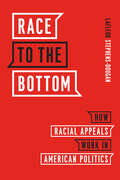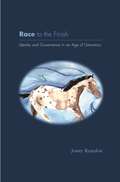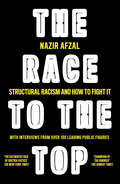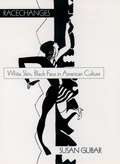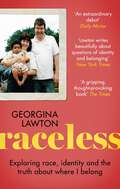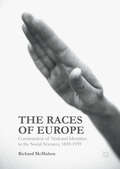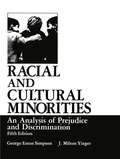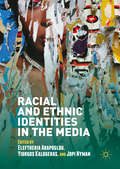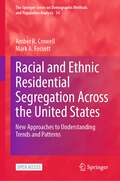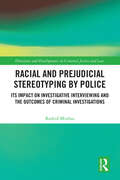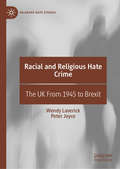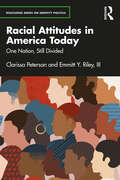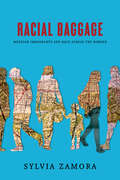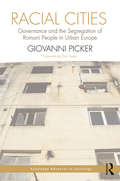- Table View
- List View
Race to the Bottom: How Racial Appeals Work in American Politics (Chicago Studies in American Politics)
by LaFleur Stephens-DouganAfrican American voters are a key demographic to the modern Democratic base, and conventional wisdom has it that there is political cost to racialized “dog whistles,” especially for Democratic candidates. However, politicians from both parties and from all racial backgrounds continually appeal to negative racial attitudes for political gain. Challenging what we think we know about race and politics, LaFleur Stephens-Dougan argues that candidates across the racial and political spectrum engage in “racial distancing,” or using negative racial appeals to communicate to racially moderate and conservative whites—the overwhelming majority of whites—that they will not disrupt the racial status quo. Race to the Bottom closely examines empirical data on racialized partisan stereotypes to show that engaging in racial distancing through political platforms that do not address the needs of nonwhite communities and charged rhetoric that targets African Americans, immigrants, and others can be politically advantageous. Racialized communication persists as a well-worn campaign strategy because it has real electoral value for both white and black politicians seeking to broaden their coalitions. Stephens-Dougan reveals that claims of racial progress have been overstated as our politicians are incentivized to employ racial prejudices at the expense of the most marginalized in our society.
Race to the Bottom: How Racial Appeals Work in American Politics (Chicago Studies in American Politics)
by LaFleur Stephens-DouganAfrican American voters are a key demographic to the modern Democratic base, and conventional wisdom has it that there is political cost to racialized “dog whistles,” especially for Democratic candidates. However, politicians from both parties and from all racial backgrounds continually appeal to negative racial attitudes for political gain. Challenging what we think we know about race and politics, LaFleur Stephens-Dougan argues that candidates across the racial and political spectrum engage in “racial distancing,” or using negative racial appeals to communicate to racially moderate and conservative whites—the overwhelming majority of whites—that they will not disrupt the racial status quo. Race to the Bottom closely examines empirical data on racialized partisan stereotypes to show that engaging in racial distancing through political platforms that do not address the needs of nonwhite communities and charged rhetoric that targets African Americans, immigrants, and others can be politically advantageous. Racialized communication persists as a well-worn campaign strategy because it has real electoral value for both white and black politicians seeking to broaden their coalitions. Stephens-Dougan reveals that claims of racial progress have been overstated as our politicians are incentivized to employ racial prejudices at the expense of the most marginalized in our society.
Race to the Bottom: How Racial Appeals Work in American Politics (Chicago Studies in American Politics)
by LaFleur Stephens-DouganAfrican American voters are a key demographic to the modern Democratic base, and conventional wisdom has it that there is political cost to racialized “dog whistles,” especially for Democratic candidates. However, politicians from both parties and from all racial backgrounds continually appeal to negative racial attitudes for political gain. Challenging what we think we know about race and politics, LaFleur Stephens-Dougan argues that candidates across the racial and political spectrum engage in “racial distancing,” or using negative racial appeals to communicate to racially moderate and conservative whites—the overwhelming majority of whites—that they will not disrupt the racial status quo. Race to the Bottom closely examines empirical data on racialized partisan stereotypes to show that engaging in racial distancing through political platforms that do not address the needs of nonwhite communities and charged rhetoric that targets African Americans, immigrants, and others can be politically advantageous. Racialized communication persists as a well-worn campaign strategy because it has real electoral value for both white and black politicians seeking to broaden their coalitions. Stephens-Dougan reveals that claims of racial progress have been overstated as our politicians are incentivized to employ racial prejudices at the expense of the most marginalized in our society.
Race to the Bottom: How Racial Appeals Work in American Politics (Chicago Studies in American Politics)
by LaFleur Stephens-DouganAfrican American voters are a key demographic to the modern Democratic base, and conventional wisdom has it that there is political cost to racialized “dog whistles,” especially for Democratic candidates. However, politicians from both parties and from all racial backgrounds continually appeal to negative racial attitudes for political gain. Challenging what we think we know about race and politics, LaFleur Stephens-Dougan argues that candidates across the racial and political spectrum engage in “racial distancing,” or using negative racial appeals to communicate to racially moderate and conservative whites—the overwhelming majority of whites—that they will not disrupt the racial status quo. Race to the Bottom closely examines empirical data on racialized partisan stereotypes to show that engaging in racial distancing through political platforms that do not address the needs of nonwhite communities and charged rhetoric that targets African Americans, immigrants, and others can be politically advantageous. Racialized communication persists as a well-worn campaign strategy because it has real electoral value for both white and black politicians seeking to broaden their coalitions. Stephens-Dougan reveals that claims of racial progress have been overstated as our politicians are incentivized to employ racial prejudices at the expense of the most marginalized in our society.
Race to the Bottom: How Racial Appeals Work in American Politics (Chicago Studies in American Politics)
by LaFleur Stephens-DouganAfrican American voters are a key demographic to the modern Democratic base, and conventional wisdom has it that there is political cost to racialized “dog whistles,” especially for Democratic candidates. However, politicians from both parties and from all racial backgrounds continually appeal to negative racial attitudes for political gain. Challenging what we think we know about race and politics, LaFleur Stephens-Dougan argues that candidates across the racial and political spectrum engage in “racial distancing,” or using negative racial appeals to communicate to racially moderate and conservative whites—the overwhelming majority of whites—that they will not disrupt the racial status quo. Race to the Bottom closely examines empirical data on racialized partisan stereotypes to show that engaging in racial distancing through political platforms that do not address the needs of nonwhite communities and charged rhetoric that targets African Americans, immigrants, and others can be politically advantageous. Racialized communication persists as a well-worn campaign strategy because it has real electoral value for both white and black politicians seeking to broaden their coalitions. Stephens-Dougan reveals that claims of racial progress have been overstated as our politicians are incentivized to employ racial prejudices at the expense of the most marginalized in our society.
Race to the Bottom: How Racial Appeals Work in American Politics (Chicago Studies in American Politics)
by LaFleur Stephens-DouganAfrican American voters are a key demographic to the modern Democratic base, and conventional wisdom has it that there is political cost to racialized “dog whistles,” especially for Democratic candidates. However, politicians from both parties and from all racial backgrounds continually appeal to negative racial attitudes for political gain. Challenging what we think we know about race and politics, LaFleur Stephens-Dougan argues that candidates across the racial and political spectrum engage in “racial distancing,” or using negative racial appeals to communicate to racially moderate and conservative whites—the overwhelming majority of whites—that they will not disrupt the racial status quo. Race to the Bottom closely examines empirical data on racialized partisan stereotypes to show that engaging in racial distancing through political platforms that do not address the needs of nonwhite communities and charged rhetoric that targets African Americans, immigrants, and others can be politically advantageous. Racialized communication persists as a well-worn campaign strategy because it has real electoral value for both white and black politicians seeking to broaden their coalitions. Stephens-Dougan reveals that claims of racial progress have been overstated as our politicians are incentivized to employ racial prejudices at the expense of the most marginalized in our society.
Race to the Finish: Identity and Governance in an Age of Genomics
by Jenny ReardonIn the summer of 1991, population geneticists and evolutionary biologists proposed to archive human genetic diversity by collecting the genomes of "isolated indigenous populations." Their initiative, which became known as the Human Genome Diversity Project, generated early enthusiasm from those who believed it would enable huge advances in our understanding of human evolution. However, vocal criticism soon emerged. Physical anthropologists accused Project organizers of reimporting racist categories into science. Indigenous-rights leaders saw a "Vampire Project" that sought the blood of indigenous people but not their well-being. More than a decade later, the effort is barely off the ground. How did an initiative whose leaders included some of biology's most respected, socially conscious scientists become so stigmatized? How did these model citizen-scientists come to be viewed as potential racists, even vampires? This book argues that the long abeyance of the Diversity Project points to larger, fundamental questions about how to understand knowledge, democracy, and racism in an age when expert claims about genomes increasingly shape the possibilities for being human. Jenny Reardon demonstrates that far from being innocent tools for fighting racism, scientific ideas and practices embed consequential social and political decisions about who can define race, racism, and democracy, and for what ends. She calls for the adoption of novel conceptual tools that do not oppose science and power, truth and racist ideologies, but rather draw into focus their mutual constitution.
Race to the Finish: Identity and Governance in an Age of Genomics
by Jenny ReardonIn the summer of 1991, population geneticists and evolutionary biologists proposed to archive human genetic diversity by collecting the genomes of "isolated indigenous populations." Their initiative, which became known as the Human Genome Diversity Project, generated early enthusiasm from those who believed it would enable huge advances in our understanding of human evolution. However, vocal criticism soon emerged. Physical anthropologists accused Project organizers of reimporting racist categories into science. Indigenous-rights leaders saw a "Vampire Project" that sought the blood of indigenous people but not their well-being. More than a decade later, the effort is barely off the ground. How did an initiative whose leaders included some of biology's most respected, socially conscious scientists become so stigmatized? How did these model citizen-scientists come to be viewed as potential racists, even vampires? This book argues that the long abeyance of the Diversity Project points to larger, fundamental questions about how to understand knowledge, democracy, and racism in an age when expert claims about genomes increasingly shape the possibilities for being human. Jenny Reardon demonstrates that far from being innocent tools for fighting racism, scientific ideas and practices embed consequential social and political decisions about who can define race, racism, and democracy, and for what ends. She calls for the adoption of novel conceptual tools that do not oppose science and power, truth and racist ideologies, but rather draw into focus their mutual constitution.
The Race to the Top: Structural Racism And How To Fight It
by Nazir AfzalA New Statesman ‘most anticipated title of the year’ 2022 ‘Compelling.’ David Lammy MP A powerful intervention roundly debunking the myth of progress in racial equality — particularly in the workplace — and offering a blueprint for the future.
Racechanges: White Skin, Black Face in American Culture (Race and American Culture)
by Susan GubarWhen the actor Ted Danson appeared in blackface at a 1993 Friars Club roast, he ignited a firestorm of protest that landed him on the front pages of the newspapers, rebuked by everyone from talk show host Montel Williams to New York City's then mayor, David Dinkins. Danson's use of blackface was shocking, but was the furious pitch of the response a triumphant indication of how far society has progressed since the days when blackface performers were the toast of vaudeville, or was it also an uncomfortable reminder of how deep the chasm still is separating black and white America? In Racechanges: White Skin, Black Face in American Culture, Susan Gubar, who fundamentally changed the way we think about women's literature as co-author of the acclaimed The Madwoman in the Attic, turns her attention to the incendiary issue of race. Through a far-reaching exploration of the long overlooked legacy of minstrelsy--cross-racial impersonations or "racechanges"--throughout modern American film, fiction, poetry, painting, photography, and journalism, she documents the indebtedness of "mainstream" artists to African-American culture, and explores the deeply conflicted psychology of white guilt. The fascinating "racechanges" Gubar discusses include whites posing as blacks and blacks "passing" for white; blackface on white actors in The Jazz Singer, Birth of a Nation, and other movies, as well as on the faces of black stage entertainers; African-American deployment of racechange imagery during the Harlem Renaissance, including the poetry of Anne Spencer, the black-and-white prints of Richard Bruce Nugent, and the early work of Zora Neale Hurston; white poets and novelists from Vachel Lindsay and Gertrude Stein to John Berryman and William Faulkner writing as if they were black; white artists and writers fascinated by hypersexualized stereotypes of black men; and nightmares and visions of the racechanged baby. Gubar shows that unlike African-Americans, who often are forced to adopt white masks to gain their rights, white people have chosen racial masquerades, which range from mockery and mimicry to an evolving emphasis on inter-racial mutuality and mutability. Drawing on a stunning array of illustrations, including paintings, film stills, computer graphics, and even magazine morphings, Racechanges sheds new light on the persistent pervasiveness of racism and exciting aesthetic possibilities for lessening the distance between blacks and whites.
Raceless: In Search of Family, Identity, and the Truth About Where I Belong
by Georgina Lawton'A poignant and eye opening memoir...a nuanced and crucial dissection of race as a construct.' Yomi Adegoke, co-author of Slay in Your Lane'a masterpiece...an invaluable read for any person with an interest in race issues in the UK.' Charlie Brinkhurst-Cuff, Editor-in-Chief at gal-dem magazine'A beautifully written account of an extraordinary story, Raceless is as eye-opening as it is profound.' Otegha UwagbaA Guardian, Sunday Times, Evening Standard and Cosmopolitan book of the year for 2021'Ideas from our parents form the backbone to our identities, the bedrock to personal truths that we recite and remember like prayers from Church or poems from school. But they condition us in more powerful ways than lessons from any book or religion ever could. Now the tale had been destroyed. So what did that mean about who I thought I was?'In Georgina Lawton's childhood home, her Blackness was never acknowledged; the obvious fact of her brown skin, ignored by her white parents. Over time, secrets and a complex family story became accepted as truth and Georgina found herself complicit in the erasure of her racial identity. It was only when her beloved father died that the truth began to emerge. Fleeing the shattered pieces of her family life and the comfortable, suburban home she grew up in, at age 22 Georgina went in search of answers - embarking on a journey that took her around the world, to the DNA testing industry, and to countless others, whose identities have been questioned, denied or erased.What do you do when your heritage or parentage has been obscured in a complex web of deceit?How can you discuss race with your family, when you each see the world differently? When a personal identity has been wrongly constructed, how do you start again? Raceless is both the compelling personal account of a young woman seeking her own story amid devastating family secrets, and a fascinating, challenging and essential examination of modern racial identity.
The Races of Europe: Construction of National Identities in the Social Sciences, 1839-1939
by Richard McMahonThis book explores a vital but neglected chapter in the histories of nationalism, racism and science. It is the first comprehensive study of the transnational scientific community that in the nineteenth and early twentieth centuries attempted to classify Europe's biological races. Anthropological race classifiers produced parallel geographies, histories and hierarchies of European peoples that were crucial to the creation of national identities and to the overtly political race discourses of eugenics and popular racist ideologues. They lent nationalism the invaluable prestige of natural science, and traced the histories, conflicts and relationships of ‘national races’ back into prehistory. Racial national character stereotypes meanwhile supported competing political ideologies. The book examines the interplay between class, gender and national identity narratives and the tensions and interactions between the scientific and political agendas of classifiers. Within the elaborate transnational networks of scientific communities, for example, they had to reconcile competing national narratives.
Racial and Cultural Minorities: An Analysis of Prejudice and Discrimination (Environment, Development and Public Policy: Public Policy and Social Services)
by George Eaton Simpson J. Milton YingerWe need scarcely note that the topic of this book is the stuff of headlines. Around the world, political, economic, educational, military, religious, and social relations of every variety have a racial or ethnic component. One cannot begin to understand the history or contemporary situation of the United States, the Soviet Union, China, Zimbabwe, South Africa, Great Britain, Lebanon, Mexico, Canada-indeed, almost any land-without careful attention to the influence of cultural and racial divisions. Preparation of this new edition has brought a strong sense of deja vu, with regard both to the persistence of old patterns of discrimination, even if in new guises, and also to the persistence of limited and constraining explanations. We have also found, however, rich new empirical studies, new theoretical perspectives, and greatly expanded activity and analyses from members of minority groups. Although this edition is an extensive revision, with reference both to the data used and the theoretical approaches examined, we have not shifted from our basically analytical perspective. We strongly support efforts to reduce discrimination and prejudice; but these can be successful only if we try to understand where we are and what forces are creating the existing situation. We hope to reduce the tendency to use declarations and condem nations of other persons' actions as substitutes for an investigation of their causes and consequences.
Racial and Ethnic Identities in the Media
by Jopi Nyman Eleftheria Arapoglou Yiorgos KalogerasThis volume examines the role and representation of ‘race’ and ethnicity in the media with particular emphasis on the United States. It highlights contemporary work that focuses on changing meanings of racial and ethnic identity as they are represented in the media; television and film, digital and print media are under examination. Through fourteen innovative and interdisciplinary case studies written by a team of internationally based contributors, the volume identifies ways in which ethnic, racial, and national identities have been produced, reproduced, stereotyped, and contested. It showcases new emerging theoretical approaches in the field, and pays particular attention to the role of race, ethnicity, and national identity, along with communal and transnational allegiances, in the making of identities in the media. The topics of the chapters range from immigrant newspapers and gangster cinema to ethnic stand-up comedy and the use of ‘race’ in advertising.
Racial and Ethnic Residential Segregation Across the United States: New Approaches to Understanding Trends and Patterns (The Springer Series on Demographic Methods and Population Analysis #54)
by Amber R. Crowell Mark A. FossettThis open access book provides new findings on and insights into trends and patterns in residential segregation between racial and ethnic groups in the United States. It draws on new methods that make it possible to investigate segregation involving small groups and segregation patterns in nonmetropolitan communities with greater accuracy and clarity than has previously been possible. As one example, the authors are able to track residential segregation patterns across a wide selection of nonmetropolitan communities where Black, Latino, and Asian populations are small but can still potentially experience segregation. The authors also track White-Latino segregation from its inception when Latino households first arrived in non-negligible numbers in new destination communities and then document how segregation changes over time as the Latino population grows over time to become larger and more established. Finally, this work shows how segregation of Latino and Asian households is fundamentally different from that of Black households based on the much greater role that cultural and socioeconomic characteristics play in shaping White-Latino and White-Asian segregation in comparison to White-Black segregation.
Racial and Prejudicial Stereotyping by Police: Its Impact on Investigative Interviewing and the Outcomes of Criminal Investigations (ISSN)
by Rashid MinhasThis book uncovers the influence of racial and prejudicial stereotyping during police investigation of suspects from stigmatised communities. The book examines the under-researched aspect of whether and how negative stereotypes appear to influence the police interviews, investigative decision-making, and outcomes of criminal investigations when officers investigate individuals from stigmatised communities as suspects of crime.In the United Kingdom, the United States, and Europe, the war on terror has been argued to impact adversely on existing race relations policies in the aftermath of terrorist activity in both the United States and Europe. Recent research has suggested that changes in legislation and counterterrorism measures have contributed to the construction and reinforcement of the Muslim community as a suspect, which, in turn, may result in police bias and prejudice towards members of Muslim communities. Based on novel and groundbreaking research studies, the author examines whether such police bias could influence the police investigation and interviewing processes concerning individuals from the suspect community as well as the outcome of a criminal investigation.The author introduces the Minhas Investigative Interviewing Prejudicial Stereotyping Scale (MIIPSS), an instrument developed and used to assess the level of police interviewers’ racial and prejudicial stereotyping towards suspects from stigmatised groups, and maintains that its use would serve to minimise the influence of racial and prejudicial stereotypes on investigation. It is further suggested that the training of police officers on the implications of such prejudicial (racial/ religious) stereotyping is essential to improving interviewing performance, case outcomes, and community cohesion.This book will benefit academics, researchers, police officers, lawyers, social policy officers, and probation officers across the globe.
Racial and Prejudicial Stereotyping by Police: Its Impact on Investigative Interviewing and the Outcomes of Criminal Investigations (ISSN)
by Rashid MinhasThis book uncovers the influence of racial and prejudicial stereotyping during police investigation of suspects from stigmatised communities. The book examines the under-researched aspect of whether and how negative stereotypes appear to influence the police interviews, investigative decision-making, and outcomes of criminal investigations when officers investigate individuals from stigmatised communities as suspects of crime.In the United Kingdom, the United States, and Europe, the war on terror has been argued to impact adversely on existing race relations policies in the aftermath of terrorist activity in both the United States and Europe. Recent research has suggested that changes in legislation and counterterrorism measures have contributed to the construction and reinforcement of the Muslim community as a suspect, which, in turn, may result in police bias and prejudice towards members of Muslim communities. Based on novel and groundbreaking research studies, the author examines whether such police bias could influence the police investigation and interviewing processes concerning individuals from the suspect community as well as the outcome of a criminal investigation.The author introduces the Minhas Investigative Interviewing Prejudicial Stereotyping Scale (MIIPSS), an instrument developed and used to assess the level of police interviewers’ racial and prejudicial stereotyping towards suspects from stigmatised groups, and maintains that its use would serve to minimise the influence of racial and prejudicial stereotypes on investigation. It is further suggested that the training of police officers on the implications of such prejudicial (racial/ religious) stereotyping is essential to improving interviewing performance, case outcomes, and community cohesion.This book will benefit academics, researchers, police officers, lawyers, social policy officers, and probation officers across the globe.
Racial and Religious Hate Crime: The UK From 1945 to Brexit (Palgrave Hate Studies)
by Wendy Laverick Peter JoyceThis book focuses on two key aspects of hate crime in the UK since 1945: those motivated by racial and religious prejudices. It examines factors that have underpinned the emergence and occurrence of racial and religious hate crime and the approaches and policies that have been pursued by the state, especially the criminal justice system, to combat this problem. Crucially, it also provides insight into the challenges that are faced in the contemporary period (especially in the wake of the 2016 EU referendum) in combatting hate crime. Additionally the book briefly considers the importance of the rhetoric of the Trump campaign and the administration's early policies to the contemporary manifestations of racial and religious hate crime.
Racial Attitudes in America Today: One Nation, Still Divided (Routledge Series on Identity Politics)
by Clarissa Peterson Emmitt Y. Riley, IIIWith this book, Clarissa Peterson and Emmitt Y. Riley, III dive into how racial attitudes change and inform political decisions. Peterson and Riley use racial resentment, black blame, and racial identity to investigate the extent to which racial attitudes influence vote choice, evaluations of Black Lives Matter, and attitudes toward public policies. Moving the conversation beyond the study of Blacks and Whites, the authors unpack the potency of racial attitudes among Asians, Blacks, Hispanics, and Whites. In doing so, they challenge our understanding of how racial attitudes are central to political decision making in an environment that is inundated with anti-Blackness. The book reframes discussions of racial attitudes to propose that, like White people, some racial minorities in the United States harbor negative attitudes toward Black people. The authors suggest that while White political attitudes are significantly explained by racial resentment, the overall influence of racial resentment on political decision making among some racial groups, may be mitigated by racial identity. At a time when White supremacists walk unhooded in the streets of America, Racial Attitudes in America Today is essential reading for educators wanting to fully engage with and understand racial resentment in America and undergraduate students in the fields of political science, sociology, history, and psychology.
Racial Attitudes in America Today: One Nation, Still Divided (Routledge Series on Identity Politics)
by Clarissa Peterson Emmitt Y. Riley, IIIWith this book, Clarissa Peterson and Emmitt Y. Riley, III dive into how racial attitudes change and inform political decisions. Peterson and Riley use racial resentment, black blame, and racial identity to investigate the extent to which racial attitudes influence vote choice, evaluations of Black Lives Matter, and attitudes toward public policies. Moving the conversation beyond the study of Blacks and Whites, the authors unpack the potency of racial attitudes among Asians, Blacks, Hispanics, and Whites. In doing so, they challenge our understanding of how racial attitudes are central to political decision making in an environment that is inundated with anti-Blackness. The book reframes discussions of racial attitudes to propose that, like White people, some racial minorities in the United States harbor negative attitudes toward Black people. The authors suggest that while White political attitudes are significantly explained by racial resentment, the overall influence of racial resentment on political decision making among some racial groups, may be mitigated by racial identity. At a time when White supremacists walk unhooded in the streets of America, Racial Attitudes in America Today is essential reading for educators wanting to fully engage with and understand racial resentment in America and undergraduate students in the fields of political science, sociology, history, and psychology.
Racial Baggage: Mexican Immigrants and Race Across the Border
by Sylvia ZamoraUpon arrival to the United States, Mexican immigrants are racialized as simultaneously non-White and "illegal." This racialization process complicates notions of race that they bring with them, as the "pigmentocracy" of Mexican society, in which their skin color may have afforded them more privileges within their home country, collides with the American racial system. Racial Baggage examines how immigration reconfigures U.S. race relations, illuminating how the immigration experience can transform understandings of race in home and host countries. Drawing on interviews with Mexicans in Los Angeles and Guadalajara, sociologist Sylvia Zamora illustrates how racialization is a transnational process that not only changes immigrants themselves, but also everyday understandings of race and racism within the United States and Mexico. Within their communities and networks that span an international border, Zamora argues, immigrants come to define "race" in a way distinct from both the color-conscious hierarchy of Mexican society and the Black-White binary prevalent within the United States. In the process, their stories demonstrate how race is not static, but rather an evolving social phenomenon forever altered by immigration.
Racial Baggage: Mexican Immigrants and Race Across the Border
by Sylvia ZamoraUpon arrival to the United States, Mexican immigrants are racialized as simultaneously non-White and "illegal." This racialization process complicates notions of race that they bring with them, as the "pigmentocracy" of Mexican society, in which their skin color may have afforded them more privileges within their home country, collides with the American racial system. Racial Baggage examines how immigration reconfigures U.S. race relations, illuminating how the immigration experience can transform understandings of race in home and host countries. Drawing on interviews with Mexicans in Los Angeles and Guadalajara, sociologist Sylvia Zamora illustrates how racialization is a transnational process that not only changes immigrants themselves, but also everyday understandings of race and racism within the United States and Mexico. Within their communities and networks that span an international border, Zamora argues, immigrants come to define "race" in a way distinct from both the color-conscious hierarchy of Mexican society and the Black-White binary prevalent within the United States. In the process, their stories demonstrate how race is not static, but rather an evolving social phenomenon forever altered by immigration.
Racial Cities: Governance and the Segregation of Romani People in Urban Europe (Routledge Advances in Sociology)
by Giovanni PickerGoing beyond race-blind approaches to spatial segregation in Europe, Racial Cities argues that race is the logic through which stigmatized and segregated "Gypsy urban areas" have emerged and persisted after World War II. Building on nearly a decade of ethnographic and historical research in Romania, Italy, France and the UK, Giovanni Picker casts a series of case studies into the historical framework of circulations and borrowings between colony and metropole since the late nineteenth century. By focusing on socio-economic transformations and social dynamics in contemporary Cluj-Napoca, Pescara, Montreuil, Florence and Salford, Picker detects four local segregating mechanisms, and comparatively investigates resemblances between each of them and segregation in French Rabat, Italian Addis Ababa, and British New Delhi. These multiple global associations across space and time serve as an empirical basis for establishing a solid bridge between race critical theories and urban studies. Racial Cities is the first comprehensive analysis of the segregation of Romani people in Europe, providing a fine-tuned and in-depth explanation of this phenomenon. While inequalities increase globally and poverty is ever more concentrated, this book is a key contribution to debates and actions addressing social marginality, inequalities, racist exclusions, and governance. Thanks to its dense yet thoroughly accessible narration, the book will appeal to scholars, undergraduate and postgraduate students, postdoctoral researchers, and equally to activists and policy makers, who are interested in areas including: Race and Racism, Urban Studies, Governance, Inequalities, Colonialism and Postcolonialism, and European Studies.
Racial Cities: Governance and the Segregation of Romani People in Urban Europe (Routledge Advances in Sociology)
by Giovanni PickerGoing beyond race-blind approaches to spatial segregation in Europe, Racial Cities argues that race is the logic through which stigmatized and segregated "Gypsy urban areas" have emerged and persisted after World War II. Building on nearly a decade of ethnographic and historical research in Romania, Italy, France and the UK, Giovanni Picker casts a series of case studies into the historical framework of circulations and borrowings between colony and metropole since the late nineteenth century. By focusing on socio-economic transformations and social dynamics in contemporary Cluj-Napoca, Pescara, Montreuil, Florence and Salford, Picker detects four local segregating mechanisms, and comparatively investigates resemblances between each of them and segregation in French Rabat, Italian Addis Ababa, and British New Delhi. These multiple global associations across space and time serve as an empirical basis for establishing a solid bridge between race critical theories and urban studies. Racial Cities is the first comprehensive analysis of the segregation of Romani people in Europe, providing a fine-tuned and in-depth explanation of this phenomenon. While inequalities increase globally and poverty is ever more concentrated, this book is a key contribution to debates and actions addressing social marginality, inequalities, racist exclusions, and governance. Thanks to its dense yet thoroughly accessible narration, the book will appeal to scholars, undergraduate and postgraduate students, postdoctoral researchers, and equally to activists and policy makers, who are interested in areas including: Race and Racism, Urban Studies, Governance, Inequalities, Colonialism and Postcolonialism, and European Studies.
Racial Climates, Ecological Indifference: An Ecointersectional Analysis (STUDIES IN FEMINIST PHILOSOPHY SERIES)
by Nancy TuanaWhile the heavy social impacts of raging wildfires, punishing storms, and climbing temperatures worldwide have made many increasingly aware of the need for climate justice, the intersection of race and climate change has too often been neglected in the literature and in practice. In Racial Climates, Ecological Indifference, author Nancy Tuana urges that engagement with histories and lineages of ecological indifference and systemic racisms leads to a more robust understanding of the nature of climate injustices. Applying her "ecointersectional" framework, Tuana reveals how racist institutions and practices often fuel environmental destruction and contribute to climate change. Building on the work of Black feminist theorists, she demonstrates that the basic social structures that generate environmental destruction are the same as those that generate systemic oppression, making clear that the more traditional focus on the differential distribution of harms and benefits of climate change, while important, constitutes only one dimension of climate injustice due to systemic racisms. This book provides a more adequate account of racial climates by disclosing the additional dimensions of climate injustice. Ultimately, Tuana underscores that any effort to protect the environment must also be a fight against systemic racisms and other forms of systemic inequity.
